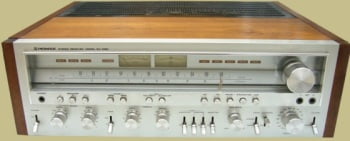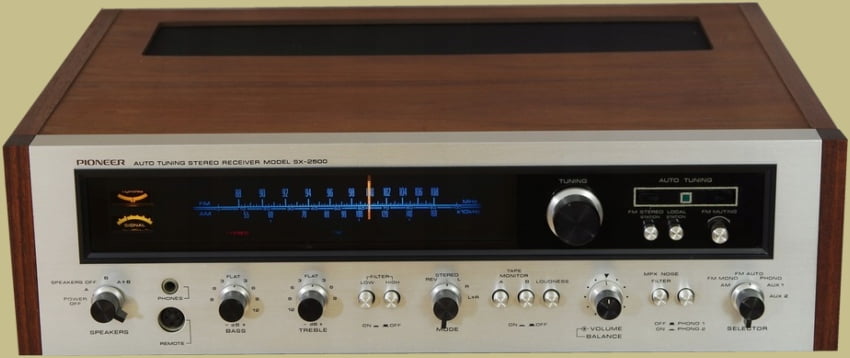
The Pioneer SX-2500 is a beautiful example of a vintage receiver from the early 70’s. It was introduced in 1971 and produces 72 watts per channel. It’s a solid state unit that features AM/FM auto-tuning, an interesting center tuning capability and included a convenient wired remote control. The SX-2500 retailed for $549.95.
Other Pioneer receivers on the market at the time included the SX-9000, SX-990, SX-1500TD, SX-1000TW, SX-770, and SX-440. The SX-2500 was the top-of-the-line receiver in that lineup.

The SX-2500 is a relatively complex piece of equipment due to its various features. Let’s begin with the tuner section. On the left side of the dial, there are center-of-channel and signal-strength meters, which are used for tuning FM and AM stations. The dial pointer lights up orange when a strong carrier signal is detected on either band. Below the dial, there are readouts for FM, stereo FM, AM, phono, and aux settings.
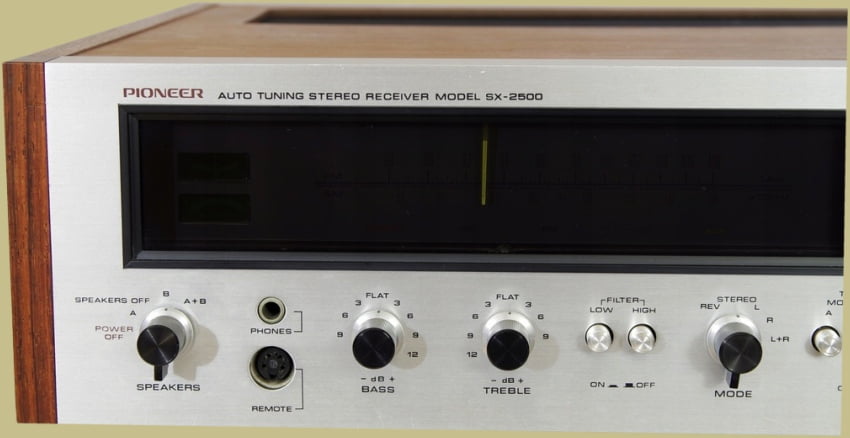
The front-panel switch provides power output options for two sets of speakers, allowing you to choose between power off, main speakers, no speakers, remote speakers, or both speaker pairs. The headphone jack remains functional in all positions except when the power is off.
Also on the front panel are several control features, including a loudness/volume switch, a mode switch with options like stereo, reverse stereo, left, right, and left-plus-right modes. There are also high and low filter switches, stepped bass and treble controls, and a headphone jack for private listening.
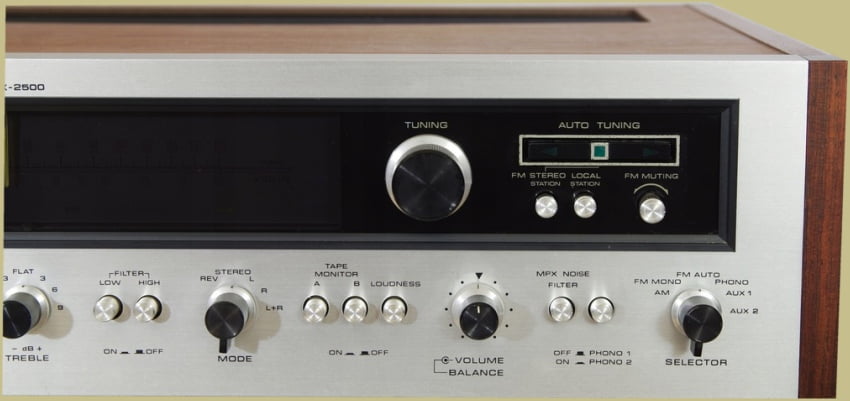
The SX-2500 offers options for connecting different phono devices. The selector switch has a single phono position, but there’s a button to the left of it that allows you to choose between phono 1 and phono 2 inputs.
On the right side of the tuning knob, there is an automatic scanning control that can search for stations on either band.
Depending on which side of the control you press, the scanning can be initiated in either direction (up or down the dial). Most auto-seek circuits of the time could only scan in one direction. Below the scanning control, there are two buttons that determine where the automatic search will stop: one for selecting stereo broadcasts only and another for choosing only local (strong) signals. There is also a “muting” knob to the right of these buttons, which determines the strength of the signal required for muting purposes. The band and mode can be selected using the main selector switch, which has positions for mono FM, automatically switched mono/stereo FM, and AM.
For tape-related functions, the SX-2500 is equipped with complete back-panel inputs and outputs for two tape decks. Tape 2 connections are of the standard phono type, while tape 1 can be connected either through similar jacks or through a DIN-style input/output jack.
Additionally, the back-panel features input jacks for the two auxiliary positions on the selector switch, allowing you to connect other devices.

For speaker connections, the SX-2500 uses speaker plugs with screw terminals and insulating covers. The prongs on these plugs are coded to ensure correct polarity, even if the plugs are moved to different speaker outlets on the back panel. An important feature to note is the intercoupling switch located to the left of the “pre out” and “main in” jacks on the back panel.
On the back panel, there are two sets of inputs for phono 2: one for a standard moving-magnet cartridge and another for a ceramic cartridge. Phono 1, on the other hand, has a single set of inputs primarily designed for a moving-magnet cartridge. To use a moving-coil cartridge with phono 1, you can plug in an accessory matching transformer (Pioneer Model PP-402 MC) into a socket located next to the one for the remote’s photoresistor unit, which converts the phono 1 input for compatibility.
The SX-2500 features three back panel speaker outputs: left, right, and center. The center output is intended for center-fill or common-bass amplifier connection, which involves using a mono amplifier to feed its own speaker.
The wide assortment of connections offer versatility for various external equipment like room equalizers, biamplification crossover units, and quadraphonic decoders. A back-panel switch allows for a direct feed from the control stage to the power amplifiers. However, if you use jumpers between the output pair and the input pair, you’ll notice a significant difference in level. This difference is due to Pioneer’s inclusion of extra amplification in the preamplifier/control section to compensate for potential losses in the equipment connected between it and the power amplifiers. The direct feed switch routes the signals through a pad circuit to bring them back to normal levels.
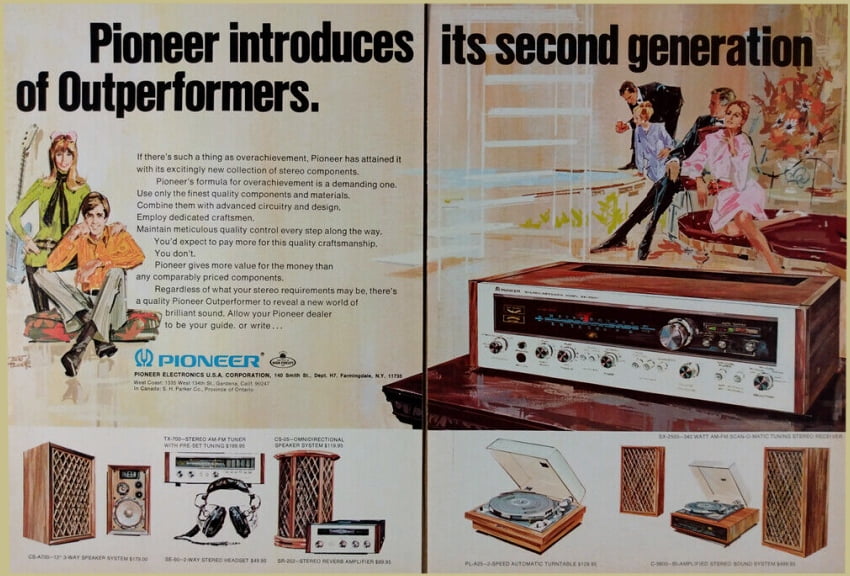
The Allied 498 receiver is a slightly simplified version of the SX-2500. The FM boards are the same, including the crystal filters in the IF section. However, the Allied 498 lacks certain features found in the SX-2500. It does not have the option to add the MC phono adapter on the side panel or the wired remote for FM/AM auto tuning. Additionally, it has slightly less flexibility, such as the absence of a switch to separate pre and main amp sections, a muting threshold knob, and a multiplex filter switch. On the other hand, the Allied model does include a “tone defeat” push button, which the SX-2500 does not have.
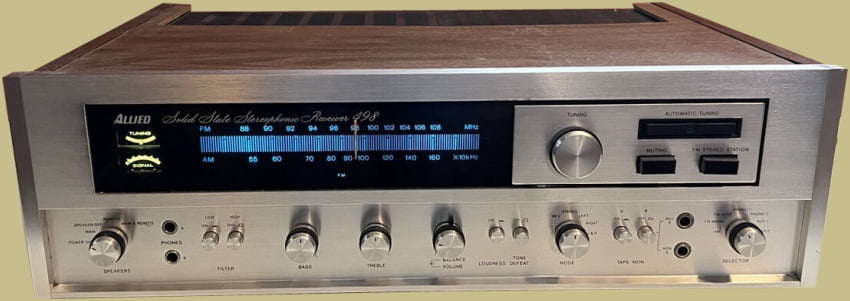
At 72 watts per channel into 8 ohms and 90 watts per channel into 4 ohms, the SX-2500 is capable of providing ample power to drive most any speakers at low distortion levels across its operating range.
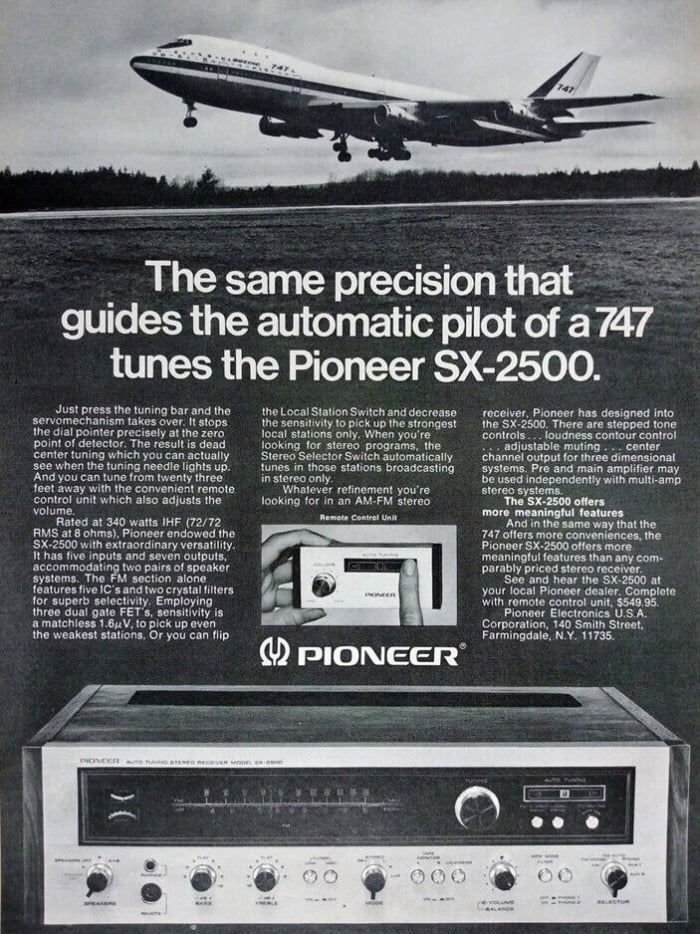
The Pioneer SX-2500 weighs approximately 33 lbs (15 kg) and measures 19 1/8 x 5 3/4 x 15 1/8 inches (486 x 146 x 384 mm).
The SX-2500 even came with a wired remote that allowed operation from distances of up to 23 feet. They are very hard to find these days. If you are looking for one be sure the CdS plug is included (if you don’t have it already), otherwise the remote will not work.
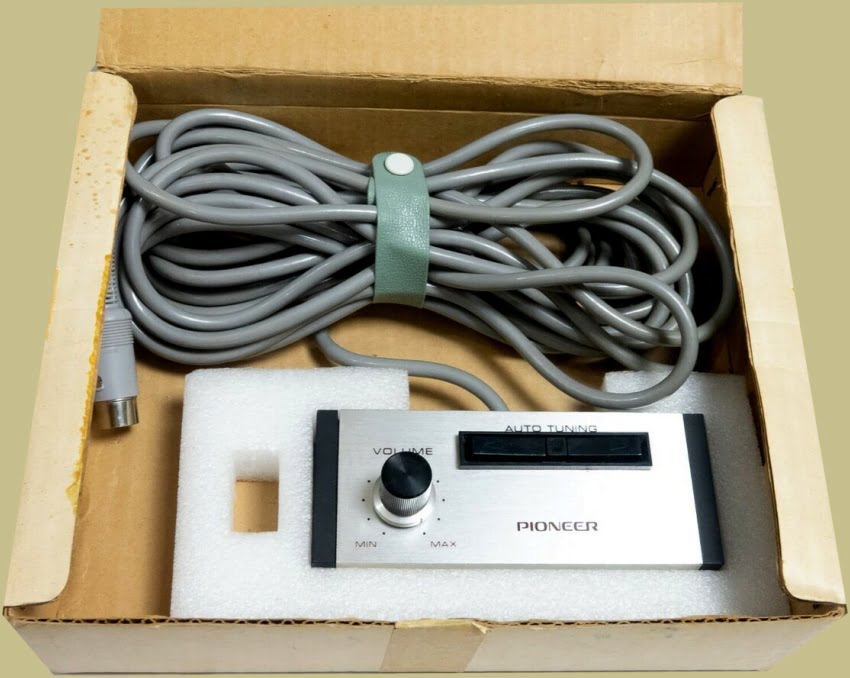
To use the remote tuning volume unit, you need to first plug a cadmium-sulfide (CdS) photoresistor element into a socket located on the right side of the receiver’s case.
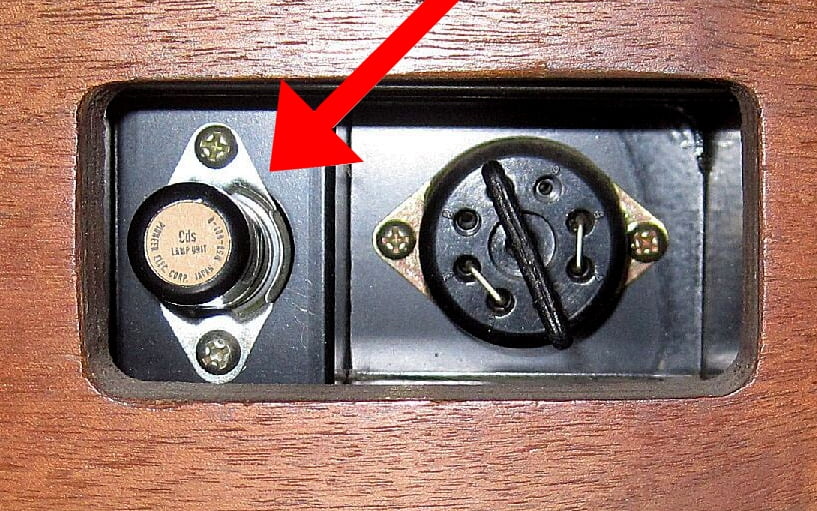
The larger socket to the right of this is where you plug in a transformer for a moving coil phono cartridge (Pioneer Model PP-402 MC Transformer).
The remote-control unit itself is plugged into a special socket on the left side of the front panel just below the headphone jack. The volume knob on the remote unit controls the current to a bulb within the CdS unit, thereby regulating the flow of signal through its resistive element. This resistive element is in series with the main volume control. To have full control range on the main volume knob, the remote volume must be set to its maximum level. The automatic tuning control on the remote unit functions similarly to the bidirectional scanning control on the front panel in terms of appearance and operation.
Here are the specs for the FM tuning section:
- Frequency Range: 87.5 MHz to 108 MHz
- IHF Sensitivity: 1.6 µV (at 98 MHz)
- Capture Ratio: 1.0 dB (at 98 MHz)
- Selectivity: 65 dB (at 98 MHz)
- Image Rejection: 90 dB (at 98 MHz)
- Signal to Noise Ratio: More than 70 dB (IHF rating)
- Antenna Input: 300 ohms balanced, 75 ohms unbalanced
- Channel Separation: 40 dB (at 1 KHz)
Here are the specs for the amplifier section:
- Circuitry: Single ended push-pull
- Music Power Output: 340 watts total at 4 ohms, 208 watts total at 8 ohms (IHF rating)
- Continuous Power Output: 120 watts/120 watts at 4 ohms (Each channel driven) (1KHz, 0.5 %) 84 watts/84 watts at 8 ohms
- Continuous Power Output: 90 watts+90 watts at 4 ohms (Both channels driven) (1KHz, 0.5%) 72 watts+72 watts at 8 ohms (1KHz, 0.5°%)
- Harmonic Distortion: Less than 0.5% (at 1KHz, Continuous power output)
- Damping Factor: 40 (at 8 ohms, 1KHz)
- Frequency Response: 20 to 70,000Hz ± 2 dB
- Power Bandwidth: 8 to 40,000Hz (IHF rating)
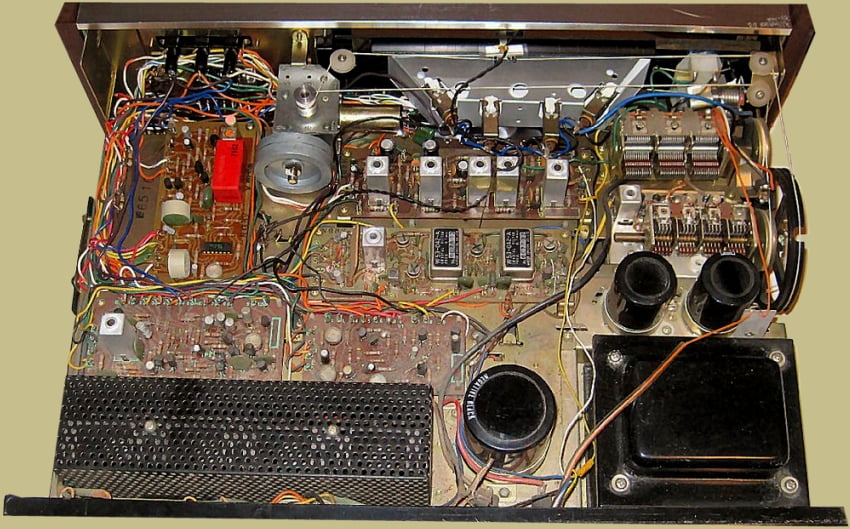
The most common parts needed for the SX-2500 are bulbs / lamps, which of course burn out over time, and those pesky speaker plugs Pioneers used on their early receivers and go missing over time. Fortunately both of these items can be found on eBay:
The Pioneer SX-2500 is a well built stereo. It’s a cap coupled amp which, according to legend, results in a fat, rich sound as opposed to the more neutral sounding direct coupled amps that followed. The styling is nice too, unless you prefer the silver face receivers that came later. The SX-2500 isn’t a common receiver so you won’t see them too often. But, they are worth acquiring if you have the chance.

